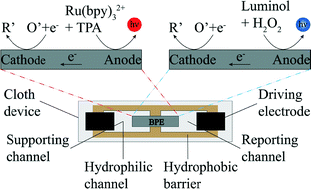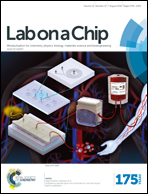A low-cost, ultraflexible cloth-based microfluidic device for wireless electrochemiluminescence application†
Abstract
The rising need for low-cost diagnostic devices has led to the search for inexpensive matrices that allow performing alternative analytical assays. Cloth is a viable material for the development of analytical devices due to its low material and manufacture costs, ability to wick assay fluids by capillary forces, and potential for patterning multiplexed channel geometries. In this paper, we describe the construction of low-cost, ultraflexible microfluidic cloth-based analytical devices (μCADs) for wireless electrochemiluminescence based on closed bipolar electrodes (C-WL-ECL), employing extremely cheap materials and a manufacturing process. The C-WL-ECL μCADs are built with wax-screen-printed cloth channels and carbon ink screen-printed electrodes, and the estimated cost per device is only $0.015. To demonstrate the performance of C-WL-ECL μCADs, the two most commonly used ECL systems – tris(2,2′-bipyridyl)ruthenium(II)/tri-n-propylamine (Ru(bpy)32+/TPA) and 3-aminophthalhydrazide/hydrogen peroxide (luminol/H2O2) – are applied. Under optimized conditions, the C-WL-ECL method has successfully fulfilled the quantitative determination of TPA with a detection limit of 0.085 mM. In addition, on the bent μCADs (bending angle (θ) = 180°), the luminol/H2O2-based ECL system can detect H2O2 as low as 0.024 mM. Based on such an ECL system, the bent μCADs are further used for determination of glucose in a phosphate buffer solution (PBS), with the detection limit of 0.195 mM. Finally, the applicability and validity, anti-interference ability, and storage stability of the C-WL-ECL μCADs are investigated. The results indicate that the proposed device has shown potential to extend the use of microfluidic analytical devices, due to its simplicity, low cost, ultraflexibility, and acceptable analytical performance.


 Please wait while we load your content...
Please wait while we load your content...